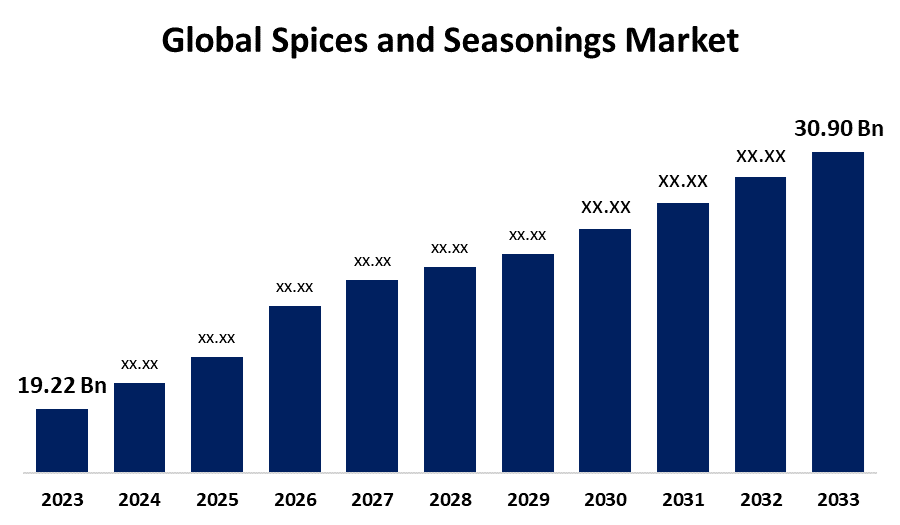Global Spices and Seasonings Market Size, Share, and COVID-19 Impact Analysis, By Type (Pepper, Chili, Ginger, Cinnamon, Cumin, Turmeric, Nutmeg, and Mace, Cardamom, Cloves, and Others), By Application (Meat and Poultry, Bakery and Confectionery, Frozen Food, Snacks & Convenience Food, and Others), and By Region (North America, Europe, Asia-Pacific, Latin America, Middle East, and Africa), Analysis and Forecast 2023 - 2033
Industry: Food & BeveragesGlobal Spices and Seasonings Market Insights Forecasts to 2033
- The Global Spices and Seasonings Market Size Was Estimated at USD 19.22 Billion in 2023
- The Market Size is Expected to Grow at a CAGR of around 4.86% from 2023 to 2033
- The Worldwide Spices and Seasonings Market Size is Expected to Reach USD 30.90 Billion by 2033
- Europe is expected to grow the fastest during the forecast period.

Get more details on this report -
The global spices and seasonings market size was worth around USD 19.22 Billion in 2023 and is predicted to grow to around USD 30.90 Billion by 2033 with a compound annual growth rate (CAGR) of 4.86% between 2023 and 2033. The market for spices and seasonings is fueled by increasing demand from consumers for flavoring, increasing health-oriented cooking interest, expanding global food discovery, and the popularity of ethnic foods. Also, growing e-commerce, organic offerings, and health advantages of some spices are driving market growth, along with new-age product launches.
Market Overview
The spices and seasonings industry is the global market dealing in the manufacturing, distribution, and sale of spices and seasonings that are added to improve the taste, aroma, and color of food and drinks. Spices are usually natural plant-based substances like chili, cinnamon, ginger, turmeric, and pepper, whereas seasonings are both single herbs and spice mixes like curry powder, garlic salt, or mixed herbs utilized in cooking and food preparation. Moreover, the world's spices and seasonings market is experiencing rapid growth as a result of increased demand by consumers for varied and genuine flavors in home-prepared and restaurant food. The knowledge of the health benefits of spices, including anti-inflammatory and antioxidant effects, is increasing their usage. Apart from this, international foods, due to globalization and cross-cultural food exchange, are increasing, thereby making different exotic spices more commonly used. In addition, the convenience foods and food processing industries also are employing more seasonings to create enhanced taste profiles to keep up with shifting consumer tastes, which is driving the market expansion.
Report Coverage
This research report categorizes the spices and seasonings market based on various segments and regions forecasts revenue growth and analyzes trends in each submarket. The report analyses the key growth drivers, opportunities, and challenges influencing the spices and seasonings market. Recent market developments and competitive strategies such as expansion, type launch, development, partnership, merger, and acquisition have been included to draw the competitive landscape in the market. The report strategically identifies and profiles the key market players and analyses their core competencies in each sub-segment of the spices and seasonings market.
Global Spices and Seasonings Market Report Coverage
| Report Coverage | Details |
|---|---|
| Base Year: | 2023 |
| Market Size in 2023: | USD 19.22 Billion |
| Forecast Period: | 2023-2033 |
| Forecast Period CAGR 2023-2033 : | 4.86% |
| 2033 Value Projection: | USD 30.90 Billion |
| Historical Data for: | 2019-2022 |
| No. of Pages: | 245 |
| Tables, Charts & Figures: | 112 |
| Segments covered: | By Type, By Application, By Region and COVID-19 Impact Analysis |
| Companies covered:: | Pepper, Chili, Ginger, Cinnamon, Cumin, Turmeric, Nutmeg and Mace, Cardamom, Cloves and others key players. |
| Pitfalls & Challenges: | COVID-19 Empact, Challenges, Future, Growth, & Analysis |
Get more details on this report -
Driving Factors
Exposure to global cuisines via travel, media, and multicultural communities has generated interest in ethnic flavors. Consumers are now using spices such as cumin, paprika, and curry blends in the home, propelling growth in specialty and ethnic spice categories globally. In addition, consumers are selecting spices such as turmeric, ginger, and cinnamon for their natural health benefits, such as anti-inflammatory and antioxidant effects. As consumers look for ways to improve immunity and limit processed additives, demand for health-supportive and functional spices grows. Restaurants, cafes, and catering businesses use huge amounts of spices to address varied customer tastes. With the growth in dining-out culture and worldwide flavors becoming trending on menus, food service bulk spice demand strongly drives the market growth.
Restraining Factor
Spices are moisture, temperature, and light-sensitive, which tend to spoil their flavor, color, and aroma over some time. Proper storage comes with a cost in terms of packaging and logistics. Improper storage causes spoilage or infestation by insects, resulting in inventory losses and product recalls that discourage its growth. Spice crops such as pepper, cardamom, and turmeric are climate- and season-sensitive. Unpredictable weather conditions, droughts, floods, or infestations can result in poor yields, impacting global supply and leading to price hikes or shortages in the market further inhibit its demand.
Market Segmentation
The spices and seasonings market share is classified into type and application.
- The pepper segment dominated the market in 2023 and is projected to grow at a substantial CAGR during the forecast period.
Based on the type, the spices and seasonings market is divided into pepper, chili, ginger, cinnamon, cumin, turmeric, nutmeg and mace, cardamom, cloves, and others. Among these, the pepper segment dominated the market in 2023 and is projected to grow at a substantial CAGR during the forecast period. The growth is attributed to pepper being one of the most widely used spices across the globe and regarded as a staple in numerous cuisines. It is utilized as a seasoning and flavoring in many food products, ranging from cooking to processed foods. Pepper forms a major ingredient in every household and is also utilized significantly in restaurants, hotels, and food services worldwide.
- The meat and poultry segment accounted for a significant share in 2023 and is anticipated to grow at a remarkable CAGR during the forecast period.
Based on the application, the spices and seasonings market is divided into meat and poultry, bakery and confectionery, frozen food, snacks & convenience food, and others. Among these, the meat and poultry segment accounted for a significant share in 2023 and is anticipated to grow at a remarkable CAGR during the forecast period. The segmental growth is due to meat and poultry being staple proteins of most foods around the globe. They are the center of a vast variety of meals, hence spices and seasonings become imperative for cooking and flavoring the meat. Regardless of whether grilling, roasting, marinating, or slow cooking is involved, spices play a crucial role in elevating the taste and aroma of meat.
Regional Segment Analysis of the Spices and Seasonings Market
- North America (U.S., Canada, Mexico)
- Europe (Germany, France, U.K., Italy, Spain, Rest of Europe)
- Asia-Pacific (China, Japan, India, Rest of APAC)
- South America (Brazil and the Rest of South America)
- The Middle East and Africa (UAE, South Africa, Rest of MEA)
Asia Pacific is anticipated to hold the largest share of the spices and seasonings market over the predicted timeframe.

Get more details on this report -
Asia Pacific is anticipated to hold the largest share of the spices and seasonings market over the predicted timeframe. India, China, Thailand, Vietnam, and Indonesia are some of the countries that have a strong culinary culture based on the utilization of spices and herbs. India and Vietnam are among the largest producers and exporters of spices in the world, and hence the region is a large consumer as well as supplier.
Europe is expected to grow at a rapid CAGR in the spices and seasonings market during the forecast period. European consumers are increasingly trying Indian, Thai, Mexican, and Middle Eastern cuisine, and this demands a wide variety of spices. This has generated new demand in restaurants and homes for international blends of spices and herbs. European consumers care most about clean-label, non-GMO, and organic food. This trend drives demand higher for natural seasoning than for artificial additives, and sells more organic spices and herbs.
Competitive Analysis:
The report offers the appropriate analysis of the key organizations/companies involved within the spices and seasonings market along with a comparative evaluation primarily based on their type of offering, business overviews, geographic presence, enterprise strategies, segment market share, and SWOT analysis. The report also provides an elaborative analysis focusing on the current news and developments of the companies, which includes type development, innovations, joint ventures, partnerships, mergers & acquisitions, strategic alliances, and others. This allows for the evaluation of the overall competition within the market.
List of Key Companies
- Ajinomoto Co. Inc.
- Sensient Technologies Corporation
- Associated British Food PLC
- Kerry Group plc
- McCormick & Company Inc.
- Baria Pepper
- Döhler GmbH
- DS Group
- Everest Spices
- Bart Ingredients
- Others
Key Target Audience
- Market Players
- Investors
- End-users
- Government Authorities
- Consulting And Research Firm
- Venture capitalists
- Value-Added Resellers (VARs)
Recent Development
- In July 2024, Bart Ingredients Company partnered with The Space Creative, an agency in Bristol, to update its brand and packaging to appeal to new food lovers as well as maintain its appeal to its long-standing customer base. Starting with redesigning the packaging of Bart's range of spice blends inspired by international cuisines, this new concept was then extended to include its large product range of over 100 items, ranging from herbs, spices, chopped ingredients, pastes, salts, peppers, and seasonings.
Market Segment
This study forecasts revenue at global, regional, and country levels from 2023 to 2033. Spherical Insights has segmented the spices and seasonings market based on the below-mentioned segments:
Global Spices and Seasonings Market, By Type
- Pepper
- Chili
- Ginger
- Cinnamon
- Cumin
- Turmeric
- Nutmeg and Mace
- Cardamom
- Cloves
- Others
Global Spices and Seasonings Market, By Application
- Meat and Poultry
- Bakery and Confectionery
- Frozen Food
- Snacks & Convenience Food
- Others
Global Spices and Seasonings Market, By Regional Analysis
- North America
- US
- Canada
- Mexico
- Europe
- Germany
- UK
- France
- Italy
- Spain
- Russia
- Rest of Europe
- Asia Pacific
- China
- Japan
- India
- South Korea
- Australia
- Rest of Asia Pacific
- South America
- Brazil
- Argentina
- Rest of South America
- Middle East & Africa
- UAE
- Saudi Arabia
- Qatar
- South Africa
- Rest of the Middle East & Africa
Frequently Asked Questions (FAQ)
-
1. What is the CAGR of the spices and seasonings market over the forecast period?The global spices and seasonings market is projected to expand at a CAGR of 4.86% during the forecast period.
-
2. What is the market size of the spices and seasonings market?The global spices and seasonings market size is expected to grow from USD 19.22 Billion in 2023 to USD 30.90 Billion by 2033, at a CAGR of 4.86% during the forecast period 2023-2033.
-
3. Which region holds the largest share of the spices and seasonings market?Asia Pacific is anticipated to hold the largest share of the spices and seasonings market over the predicted timeframe.
Need help to buy this report?